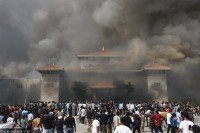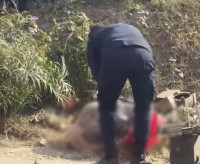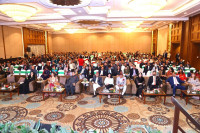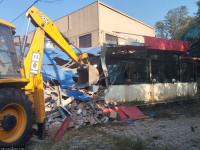Valley
New luxury buses alleviate commuters’ daily ordeal
Increase in the number of luxury buses this year has given some relief to Kathmandu Valley commuters who regularly face the ordeal of travelling in overcrowded microbuses.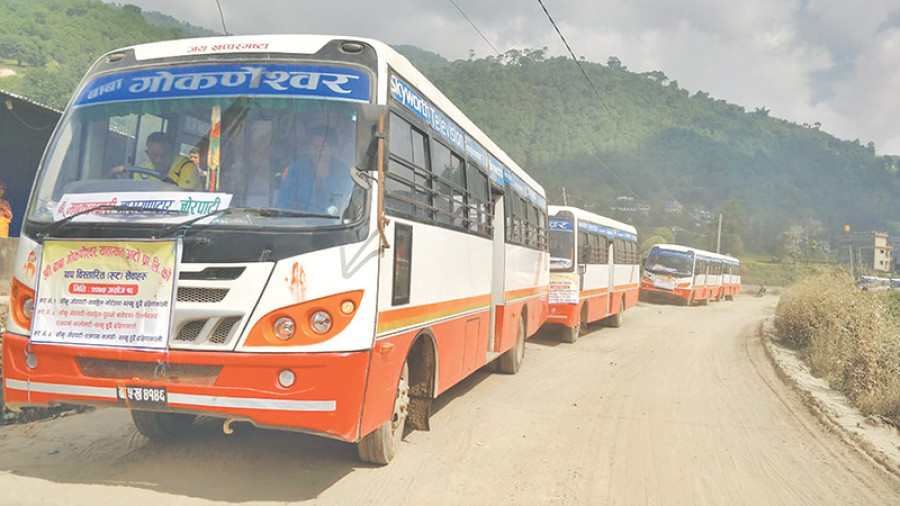
Anup Ojha
Increase in the number of luxury buses this year has given some relief to Kathmandu Valley commuters who regularly face the ordeal of travelling in overcrowded microbuses.
Baba Gokarneshwor Yatayat Pvt on Tuesday launched 24 new city buses to ply around the 50-km route that links two religious hubs Sakhu, the ancient Newar town located north-east of Kathmandu valley to Dakshinkali in the southern outskirts.
The 41-seat bus transport service reserves seats for journalists, elderly people and pregnant women. The buses are equipped with of LED television, CCTV surveillance camera and Global Positioning System. The bus fare is Rs95 for public and Rs 45 for students.
Yatayat’s Secretary Roshan Babu Shrestha said, “Earlier we deployed our buses from Ring Road to Ratnapark. We have extended service to two religious hubs. We are working to gain goodwill from our passengers and won’t compromise in our service.”
Over one dozen private transporters ply luxury buses in the Valley. Sajha Yatayat Co-operative was the first service to introduce in the city, 16 imported Euro III emission standard buses with automated doors from Indian heavy vehicles manufacturer Ashok Leyland. The 55-seat buses can ferry over 90 passengers with CCTV surveillance.
This move inspired other private bus operators.
Currently, Sajha operates 51 city buses. Their fleet includes one semi-floor bus and four deluxe buses that serve localities the Valley and beyond.
On Tuesday, the cooperative announced to import 20 more deluxe buses from India within three months.
Lalitpur Transport Management Office (TMO) Chief Basanta Prasad Panthi said, Sajha was the pioneer in the Valley transportation.
“After Sajha earned passengers’ goodwill, private companies felt insecure and they too introduced luxury buses in the city. Competition immensely transformed the Valley’s transportation system,” said Panthi.
Operating bus services for 17 years in various parts of the Valley, Nepal Yatayat has now started 10 large buses in Kathmandu.
Nepal Yatayat Secretary Gobinda Gurung said, “Most of our buses are old. We plan to add more big and sophisticated city buses because we need to match our competitors.”
In June, Kathmandu Sustainable Urban Transport Project (KSUTP) operated 17 big buses from New Bus Park –Gongabu-Dillibazar-Sinamangal to the airport, replacing microbus and tempos. It also allocated 8-primary, 16-secondary and 40-tertiary bus routes in the Valley.
Talking to the Post, Environmentalist Bhusan Tuladhar lauded private investments in city transport service.
“The government should follow the route made by the KSUTP. It should build a sophisticated infrastructure network that manages bus route information so that people know the exact location of the buses,” said Tuladhar.
He urged the government to open a separate office to manage Kathmandu Valley’s transport system.
“The TMO is busy issuing license and renewing it. An exclusive office managing the city transport system would make it efficient,” he said.
Currently, Mahanagar Yatayat operates 39 large city buses with sophisticated facilities on Ring Road. City Metro deploys 15 city buses, with over 40 seats, from Kadaghari to Banasthali. Orange Yatayat operates 55-seat buses on Ring Road with a wide corridor and hanger stripes. Other bus operators that ply within Kathmandu valley are Rato Bus, Kathmandu-Bhaktapur Nagar Bus, Madhya Upateka Yatayat, and Swyambhu Yatayat.
After the government granted route permit to Mayor Yatayat, five more private transport companies also received the go-ahead to operate large buses on Kathmandu-Dhulikhel route the in city, according to TMO report.




 9.12°C Kathmandu
9.12°C Kathmandu.jpg)
